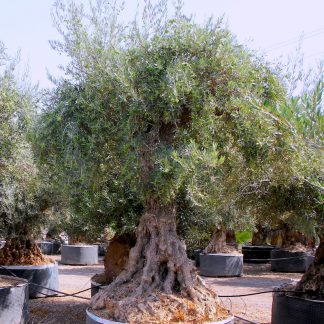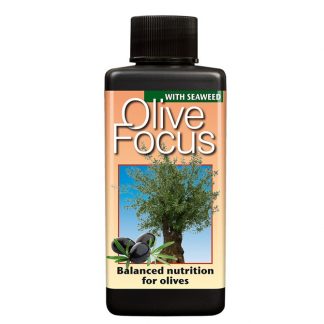The olive tree, Olea europaea is instantly recognisable as the quintessential Mediterranean tree and stands as the archetypal sentinel of warm, sunny climes. It is then perhaps surprising that the olive tree is an adaptable and hardy plant suitable for growing in a wide range of climates. In the UK, olive trees perform well in the milder microclimates which to generalise, are southern and western regions, coastal areas and urban locations.
Growing your Olive tree
To ensure you give your olive tree the best possible start to life, just follow these criteria:
- Site in the sunniest position possible, ideally south or west facing with some protection from the north and east winds
- Plant in free-draining soil that will not become waterlogged during the wetter parts of the year; olives are tolerant of both acidic and alkaline soils. Poor sandy soils will benefit from the addition of organic compost and clay soils may require additional drainage or if this is not feasible, then consider a raised bed.
- Olive trees can successfully grow in containers for many years and while they will grow in most composts, for long-term cultivation we recommend mixing a good quality multipurpose compost 50/50 with John Innes No.3. Never over-pot your olive tree and always re-pot just to a slightly larger pot.
- Olive trees can be easily pruned to maintain the size and habit required. We recommend that light, formative pruning is undertaken in mid-spring with heavier trimming in early to mid-summer. Never prune during the winter and be cautious in the autumn: like many Mediterranean trees, olives need some heat and recovery time to heal wounds before the dormant winter period.
- Feed your olive tree with seaweed extract fortnightly between May and September to ensure the tree stays healthy, vigorous and happy.
Winter Protection
In areas where the minimum winter temperatures are between -2?C and -5?C, olive trees require no winter protection and will even tolerate drops down to -7?C for short periods, providing the daytime temperature rises sufficiently. In areas of lower winter temperatures, your olive tree can be protected with several layers of horticultural fleece wrapped around the trunk and crown of the tree.
Like many plants grown in pots, olive trees have not yet evolved to tolerate frozen roots; if this happens, they can suffer drought through not being able to take up water or worse still, the roots will be damaged which can result in subsequent poor growth or even death of the tree.
But fear not! This can be prevented by adding several layers of bubble plastic to the inside of the pot when re-potting the plant or simply add layers of bubble plastic to the outside of the pot and secure with twine (not quite as attractive, but just as effective).
Fruit Production
Now the exciting bit, can I produce olives outside in the UK and are they edible? Yes and yes, provided you have the correct olive cultivar and you prepare your olives in the manner shown in our olive recipe. At Big Plant Nursery we have been growing and researching olive tree varieties for many years and have selected a range most suitable for UK gardening.
Recipes
As you may have discovered, olives cannot be eaten straight from the tree, they need some preparation before they are palatable. A few years ago, this recipe was given to us by one of our customers, who told us that the resulting olives were very tasty. So for those of you who fancy serving home-grown marinated olives at your next dinner party, just follow the recipe below.
Before marinating olives, it is necessary to pickle them to get rid of any impurities.
Pickled olives
Pickled olives are ready to eat after around 5 weeks in salted water. It is very important that at the beginning, you do not mix ripe (black) and unripe (green) olives.
The quantities of ingredients used in this recipe are based on pickling 1.5kg of freshly harvested olives, so you may need to adjust the quantities depending on the size of your tree!
- Make two cuts lengthways into each olive, through to the stone, using a sharp knife. Place the olives in sterilised jars until the jars are two-thirds full. Cover the olives with water then fill a small plastic bag with water, tie securely and sit the bag on top of the olives to keep them submerged.
- Scum and impurities will soon appear on the surface of the water. Change the water in the jars every day and continue to do so for 6 days.
- Once this is done, combine 1 litre of water and 75g of sea salt in a pan and gently warm until the salt has dissolved and allow to cool. Drain the cleansing water from the jars and pour in enough of the salted water to cover the olives. Add a layer of olive oil to the jars to make an airtight seal over the olives.
- Leave for 5 weeks covered in a cool, dark spot. After this, they will be ready to eat but they can stay like this for around 6 months.
Marinated olives
Drain 600g of the pickled olives, place in a clean jar and add one sliced garlic clove, 2 lemon wedges, a sprig of fresh dill and enough olive oil to cover the olives. These olives will be ready to eat after two weeks and will happily store for several months in a cool, dark place.
For any further information about your Olive tree, please either call us on 01903 891466 or email us at info@bigplantnursery.co.uk and we will be glad to help.



